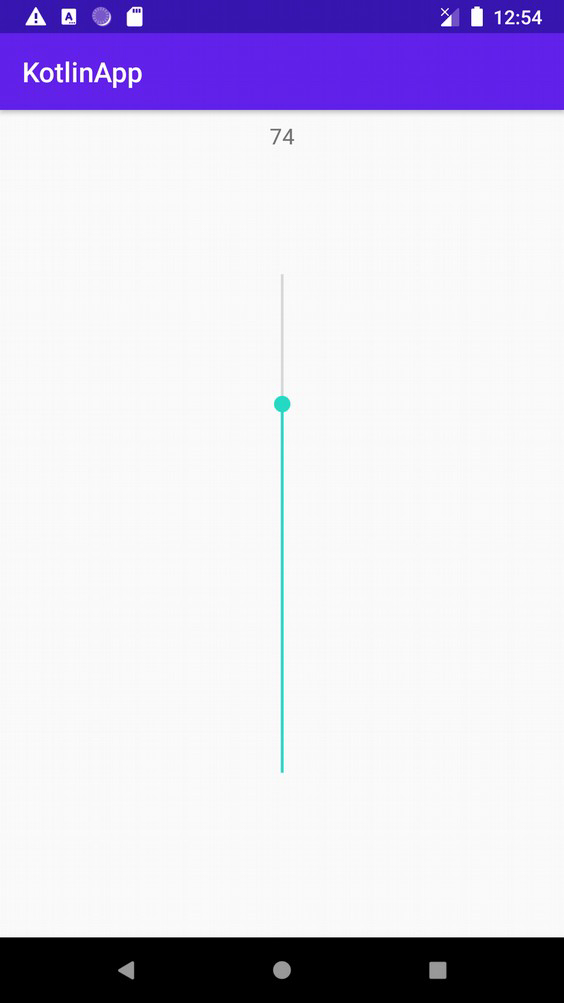如何使用 Kotlin 在 Android 中獲取一個工作的垂直 SeekBar?
本例演示如何使用 kotlin 在 Android 後臺服務中監聽音量按鈕。
步驟 1 − 在 Android Studio 中建立一個新專案,轉到檔案?新建專案,並填寫所有必需的詳細資訊來建立一個新專案。
步驟 2 − 將以下程式碼新增到 res/layout/activity_main.xml。
示例
<?xml version="1.0" encoding="utf-8"?> <RelativeLayout xmlns:android="http://schemas.android.com/apk/res/android" xmlns:tools="http://schemas.android.com/tools" android:layout_width="match_parent" android:layout_height="match_parent" android:padding="8dp" tools:context=".MainActivity"> <SeekBar android:id="@+id/seekBar" android:layout_width="match_parent" android:layout_height="wrap_content" android:layout_centerInParent="true" android:rotation="270" /> <TextView android:id="@+id/textView" android:layout_width="wrap_content" android:layout_height="wrap_content" android:layout_alignParentTop="true" android:layout_centerHorizontal="true" android:text="" android:textSize="16sp" /> </RelativeLayout>
步驟 3 − 將以下程式碼新增到 src/MainActivity.kt
示例
import android.os.Bundle
import android.widget.SeekBar
import android.widget.SeekBar.OnSeekBarChangeListener
import android.widget.TextView
import androidx.appcompat.app.AppCompatActivity
class MainActivity : AppCompatActivity() {
lateinit var seekBar: SeekBar
lateinit var textView: TextView
var min = 0
var max: Int = 100
var current: Int = 50
override fun onCreate(savedInstanceState: Bundle?) {
super.onCreate(savedInstanceState)
setContentView(R.layout.activity_main)
title = "KotlinApp"
textView = findViewById(R.id.textView)
seekBar = findViewById(R.id.seekBar)
seekBar.progress = max - min
seekBar.progress = current - min
textView.text = "" + current
seekBar.setOnSeekBarChangeListener(object : OnSeekBarChangeListener {
override fun onProgressChanged(seekBar: SeekBar, progress: Int, fromUser: Boolean) {
current = progress + min
textView.text = "" + current
}
override fun onStartTrackingTouch(seekBar: SeekBar) {}
override fun onStopTrackingTouch(seekBar: SeekBar) {}
})
}
}步驟 4 − 將以下程式碼新增到 src/SettingsContentObserver.kt
示例
<?xml version="1.0" encoding="utf-8"?> <manifest xmlns:android="http://schemas.android.com/apk/res/android" package="app.com.myapplication"> <application android:allowBackup="true" android:icon="@mipmap/ic_launcher" android:label="@string/app_name" android:roundIcon="@mipmap/ic_launcher_round" android:supportsRtl="true" android:theme="@style/AppTheme"> <activity android:name=".MainActivity"> <intent-filter> <action android:name="android.intent.action.MAIN" /> <category android:name="android.intent.category.LAUNCHER" /> </intent-filter> </activity> </application> </manifest>
讓我們嘗試執行你的應用程式吧。我假設你已經將你的真機 Android 移動裝置與電腦連線。要在 android studio 中執行應用程式,開啟你的一個專案活動檔案並從工具欄中單擊執行圖示![]() 。選擇你的移動裝置作為選項,然後檢查你的移動裝置,它會顯示你的預設螢幕
。選擇你的移動裝置作為選項,然後檢查你的移動裝置,它會顯示你的預設螢幕


廣告

 資料結構
資料結構 網路
網路 RDBMS
RDBMS 作業系統
作業系統 Java
Java iOS
iOS HTML
HTML CSS
CSS Android
Android Python
Python C 程式設計
C 程式設計 C++
C++ C#
C# MongoDB
MongoDB MySQL
MySQL Javascript
Javascript PHP
PHP